Goldfish have been favorite family pets for hundreds of years. One of the most popular varieties with hobbyists today is the Oranda Fancy variety.
In this guide, you can learn about the origins of these beautiful fish, why they are such popular family pets, and how to care for them.
Oranda Goldfish – At A Glance
Scientific Name
Carassius auratus auratus
Common Name (species)
Oranda, Bubblehead Goldfish, Tiger Goldfish, Tiger Fish
Family
Cyprinidae
Origin
Captive-bred hybrid
Diet
Omnivore
Care Level
Beginner
Activity
Moderately active scavengers
Lifespan
10 to 15 years or more life expectancy
Size
Up to 7 inches
Temperament
Peaceful species of community fish
Tank Level
All areas of the water column
Minimum Tank Size
20 gallons
Temperature Range
65° to 74° Fahrenheit
Water Hardness
5 to 19 dGH
pH Range
6.5 to 7.5
Filtration/Flow Rate
Requires powerful filter with a low flow rate
Water type
Freshwater
Breeding
Egg-layers; can breed readily in ponds
Compatibility
Egg-layers; can breed readily in ponds
OK, for Planted Tanks?
Diggers and can nibble on new leaves and shoots
Habitat
Oranda goldfish were developed from a wild species of Prussian carp, so there are no wild populations of these goldfish. However, all goldfish share the same basic habitat preferences as their distant carp relatives of slow-moving waters, such as ponds, lakes, and ditches.
Pond-kept goldfish eat algae, insect larvae, small crustaceans, and plant matter.
Compatibility and Tankmates
Oranda goldfish are peaceful creatures that thrive when kept in the company of their own kind. Orandas also do well with other types of Fancy goldfish and larger species of coldwater and temperate water fish.
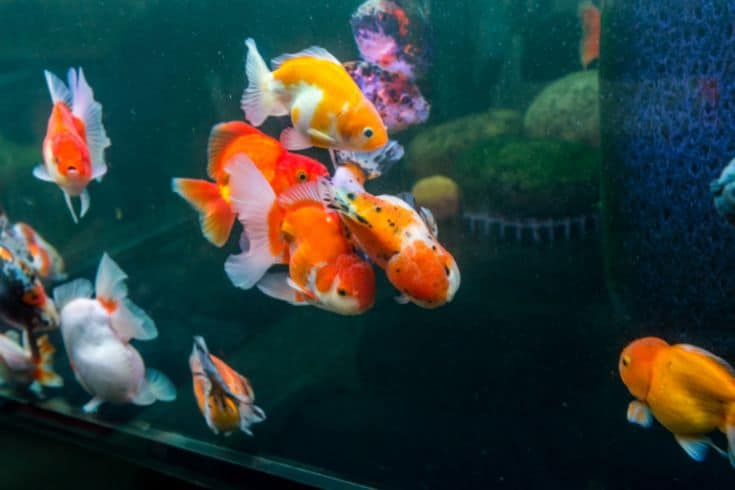
Never keep one goldfish on its own! These highly social fish need to live in small groups or at least as a pair. In fact, it’s illegal in Switzerland to keep a single small goldfish alone on welfare grounds!
Fish to Avoid
Their round body shape and obscured vision make Orandas dreadful swimmers! In fact, in some cases, the web grows so large it covers the fish’s eyes completely, effectively leaving the animal blind. In extreme cases, delicate surgery is required to remove or trim the wen for welfare reasons.
For that reason, we recommend not putting fast swimmers, such as Shubunkins or Comets, with Orandas. The slower fish will be outcompeted for food. and there’s also the risk of them being bumped into and injured.
Large Oranda goldfish will eat tiny fish, such as White Cloud Mountain Minnows, and Mosquitfish and shrimp are on the menu too. However, most snail species make a useful cleanup crew for the tank, and the goldfish won’t bother with them.
Feeding
What to Feed Oranda Fancy Goldfish
Oranda goldfish are omnivorous fish that eat a mixture of meaty protein, algae, and plant matter. So, you should provide your fish with a varied balance of Fancy goldfish flakes or pellets, frozen foods, and fresh veggies, such as zucchini and lettuce.
Feed to Prevent Digestive Problems
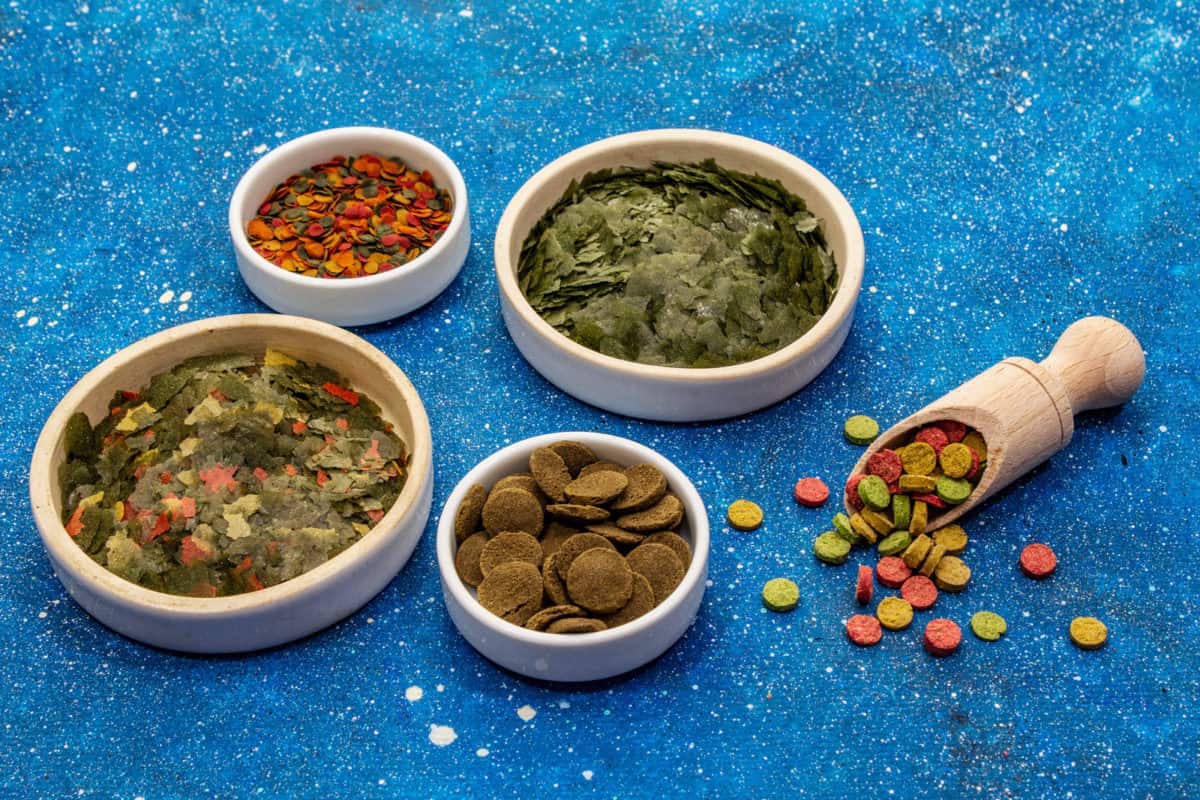
Round-bodied goldfish are susceptible to digestive problems, including bloating, Swim Bladder disease, and constipation, if they only receive dried food.
I’ve always found that feeding my goldfish a mixture of high-quality Fancy goldfish pellets and dried foods, such as bloodworms, tubifex worms, daphnia, and mosquito larvae, helps to keep their digestion working properly and avoids those health issues I mentioned earlier.
Feeding Frequency
Oranda goldfish are greedy fish, so it’s easy to overfeed them.
I recommend feeding your fish twice daily, offering only what they will clear up in a couple of minutes.
What Not To Feed
As mentioned above, you should avoid feeding your Orandas only on regular fish flakes, as that can cause health problems.
Although Orandas will happily gobble up live foods, using live food is a good way to introduce bacteria and parasites into your tank. If you want to give your fish live food, I suggest setting up a home brine shrimp hatchery if you have the space and time.
Tank Requirements
Tank size
You need a tank of at least 20 gallons for a pair of juvenile Orandas. For every additional fish, be prepared to add a further 10 gallons, and don’t forget to allow sufficient space for any tank mates you want to include.
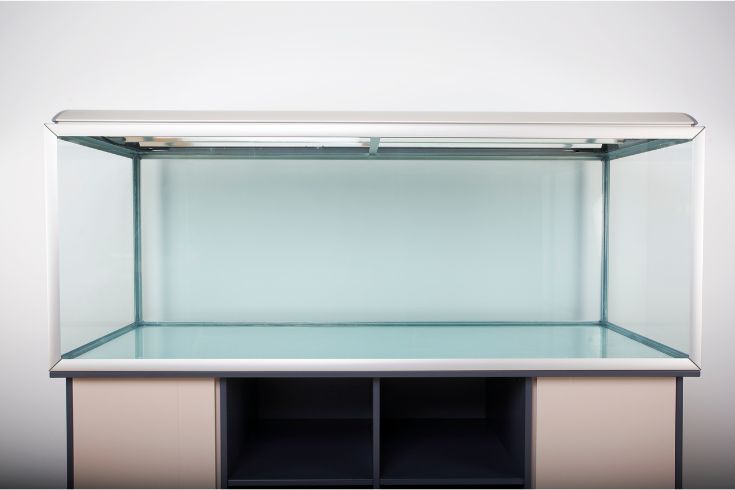
A rectangular tank is best so that the fish have plenty of space and can get to the surface easier to feed. In addition, goldfish are oxygen-hungry creatures, and a rectangular tank provides more surface area for efficient gaseous exchange than a tall one.
Never keep goldfish in a fishbowl! Bowls don’t offer enough space and can’t accommodate a powerful, efficient filter system to cope with goldfish.
Tank Setup
Orandas can live in whatever setup you prefer, although do bear in mind that these clumsy swimmers need plenty of unobstructed space in which to move around safely, so don’t clutter the tank with too many decorations.
Substrate
The best choice of substrate for a Fancy goldfish tank is medium-gauge gravel. The fish love to root through the substrate, hunting for food scraps, and gravel helps plant roots to become more securely anchored.
Decoration
Orandas are poor swimmers, and their eyes are often covered by their wen, so always leave lots of swimming space for them.
Don’t use anything sharp that could damage the Oranda’s flowing finnage or the fleshy growth of the wen, and place larger items of tank decoration at the tank’s perimeter where they won’t obstruct the swimming space and present a hazard to the fish.
Plants
All goldfish varieties are enthusiastic diggers, and they tend to uproot any plants that are not securely anchored.
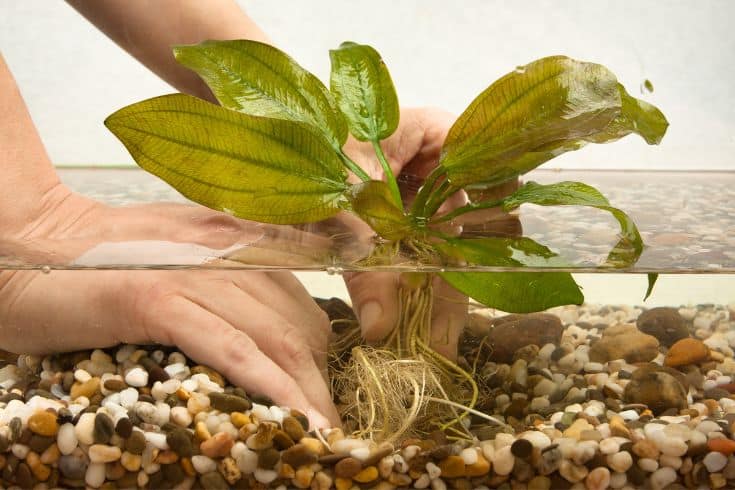
Choose hardy plant species that will tolerate being nibbled and will form secure roots. Alternatively, go for floating plants or pick varieties that grow best when tied to pieces of wood or rocks.
Habitat Requirements
Filtration
Orandas are dirty fish that produce lots of waste. So, you need a powerful external filter system to cope. Since Orandas are weak swimmers, you’ll need to buffer the flow to prevent the fish from getting stressed.
Water Parameters
Goldfish are generally hardy creatures that will tolerate a fairly wide variance in water parameters, provided conditions remain stable.
Water Temperature
Orandas are coldwater fish, needing a water temperature of between 65o and 74o Fahrenheit.
The water pH should be between 6.0 to 8.0, with a water hardness of 5 to 19 dGH.
Lighting
Regular LED lighting is fine for Oranda goldfish, so just pick a unit that suits your plants’ requirements.
Tank Maintenance
Goldfish are very dirty fish, and you need to keep their tank water clean by performing weekly 30% water changes.
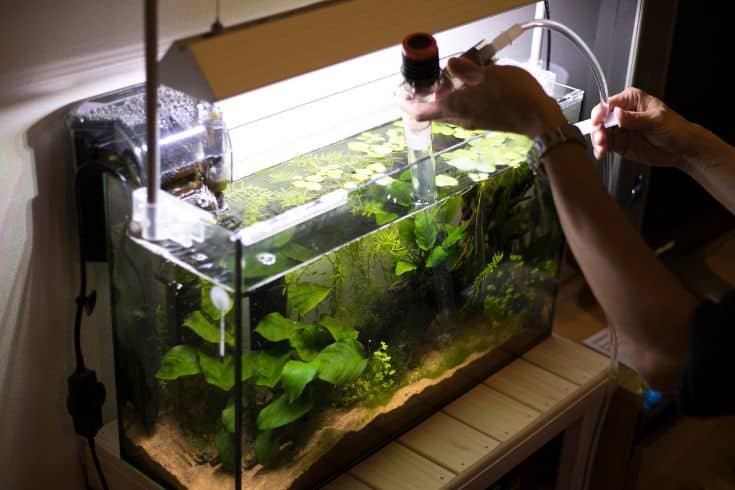
Clean the substrate with an aquarium vacuum to get rid of organic debris and leftover food, and use an algae magnet to clean the viewing panes.
Every couple of weeks, rinse the filter media in tank water to clear away sludge so that the water flow through the unit is not disrupted. Replace old filter media regularly, in line with the manufacturer’s guidelines.
Setting Up the Aquarium
Assemble everything you need to set up the tank, including the following:
- Canister or HOB filtration system
- LED lighting unit
- Plants
- Gravel substrate
- Smooth rocks, driftwood, etc.
- Water dechlorinator
How to Set up the Aquarium
- Wash the gravel under running water.
- Add substrate to the tank to a depth of a few inches. Set an upturned plate on top of the substrate.
- Fit the filter and heater, but don’t switch them on.
- Add dechlorinated tap water to an inch below the aquarium’s fill line. Slowly pour the water over the upturned plate to not displace the substrate.
- Add a small amount of pure ammonia or some fish flakes to the water to kick off the nitrogen cycle.
- Wash the décor to remove dust, and arrange everything in the fish tank.
- Tidy up live plants by removing dead leaves and damaged stems, and add them to your tank.
- Turn on the heater and filter. Living plants require between eight and ten hours of light daily for photosynthesis, so you’ll need to turn on your lights if you’re keeping live plants.
You must allow at least ten days for the tank to cycle fully before adding any fish.
Test the water daily until ammonia and nitrite levels are zero and nitrates are 20ppm or less.
Health and Disease
Oranda goldfish are quite hardy fish, although they can suffer from a few health issues. For example, the wen can develop infections and sustain injuries, and the fish are prone to constipation and swim bladder problems.
Signs of Good Health
Oranda goldfish spend much of their time foraging for food scraps in the substrate or swimming in loose groups in all areas of the water column with their tank mates.
Red Flags
Red flags that could indicate health problems include the following:
- Not eating
- Floating at the water’s surface, unable to swim down
- Resting on the substrate
- Skin damage, sores, ulcers, or red areas
- Rubbing against the substrate or items of tank décor
- Inability to swim on an even keel.
- Not socializing with tank companions
Common Health Issues and Suggested Treatments
Health Issue
Ich (White Spot Disease)
Symptoms or Causes
Ich is a very common disease that’s caused by an aquatic protozoan parasite.
Fish infected with Ich develop a sprinkling of tiny white spots on their fins, gill covers, and bodies. They also flash against the gravel and other solid objects in the aquarium.
Suggested Action
Raise the water temperature to 82o F for three days. Use an OTC White Spot Disease medication to treat the tank.
Health Issue
Flukes
Symptoms or Causes
Flukes is the term used to describe various types of external fish parasites. These macroparasites can often be seen with the naked eye attached to the fish’s skin or gills.
Suggested Action
Treat the fish tank with an OTC antiparasitic medication.
Health Issue
Fungal infections
Symptoms or Causes
White fluffy growths on the fish’s body, mouth, and head.
Suggested Action
Quarantine infected fish, and treat with an antifungal medication.
Health Issue
Bacterial infections
Symptoms or Causes
Sores and ulcers on the body and head, ragged, bloody fins.
Suggested Action
Treat the tank with OTC antibacterial treatment.
Breeding
Oranda goldfish are egg-layers that will breed readily in ponds and in your aquarium, usually when the water is warmer in the spring.
Spawning Tank
Set up a 20-gallon spawning tank with spawning mops or bushy plants and some flat rocks for the eggs to stick to.
When spawning starts, reduce the water temperature to around 60° Fahrenheit. Gradually increase the temperature by 3° per day until spawning starts, usually when the water is between 68° and 74° Fahrenheit.
Throughout the build-up to spawning, continue to live food sourced from a reliable supplier.
Spawning Behavior
Before spawning, male fish chase a female around the tank, and their colors become more vibrant and intense.
The mating process often takes a few hours, and the female fish can lay as many as 10,000 eggs!
The Eggs and Fry
Once the eggs are laid and fertilized, remove the parents so that they don’t eat them.
After four to seven days, the eggs hatch, releasing free-swimming fry. You can feed the fry on infusoria and commercial fry food, changing to finely crushed flakes and tiny baby brine shrimp when the fry is large enough to cope with it.
Availability
Oranda goldfish are available from most fish and pet stores. However, if you want one of the more unusual color morphs, you’ll probably get one from an online breeder.
Orandas vary in price from a few dollars to a few hundred, depending on the color, quality, and fins of the individual.
Product Recommendations
- Algae magnet
- Fish tank (minimum size 20 gallons)
- Aquarium vacuum
- Books on keeping Fancy goldfish
- Filter system
- Medium-gauge gravel
- High-quality fancy goldfish pellets, frozen meaty foods
- LED lighting unit
- Live plants (optional)
- Smooth rocks, driftwood, etc.
- Water dechlorinator
FAQs
In this part of our guide, we answer some of the most commonly asked questions about keeping Oranda goldfish.
Q: Are Oranda goldfish easy to take care of?
A: Goldfish are hardy, long-lived fish that are pretty straightforward to care for. However, they do make a lot of mess, so you must be prepared to spend time cleaning and maintaining their tank.
Q: Can Oranda goldfish live with other fish?
A: Yes, there are several coldwater fish species that make good tank mates for Orandas, including loaches, Plecos, and Platies. However, I don’t recommend keeping shrimp with goldfish, as the fish will view the inverts as a food source.
Q: Can Oranda goldfish live without a heater?
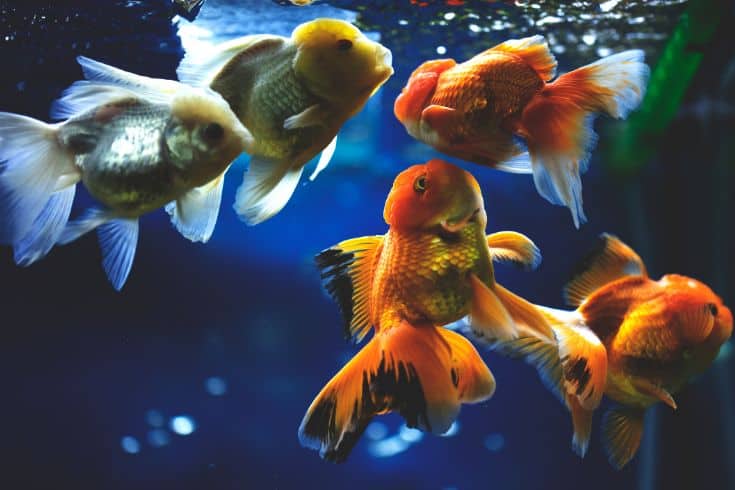
A: Oranda goldfish prefer cool water between 68° and 74°F, so you don’t need a heater for their tank. Oranda goldfish can also live happily in an outdoor pond in regions with a temperate climate.
Q: Can Oranda goldfish bite?
A: Goldfish don’t have teeth, so they cannot bite you. However, my goldfish became so friendly they would take food from my fingers, gently sucking at my hand, too!
Q: Do Oranda goldfish lay eggs?
A: Oranda goldfish are egg-layers, and you can often breed them in your home tank or pond relatively easily.
Q: Do Oranda goldfish like warm water?
A: Although Orandas can tolerate water up to around 74°F, they prefer cooler conditions. However, increasing the water temperature gradually by a few degrees can encourage spawning.
Final Thoughts
Did you enjoy our guide to caring for the beautiful Oranda Fancy goldfish? If you did, please remember to share it!
Orandas are pretty straightforward to keep, provided you give them a large tank or spacious pond. These fish can grow pretty large, and they are very dirty, so you’ll need to devote lots of time to the care and maintenance of their tank.
If you have Oranda Fancies, do you keep them in a fish tank or a pond? Tell us about your pets in the comments box below!